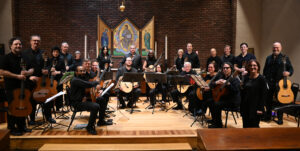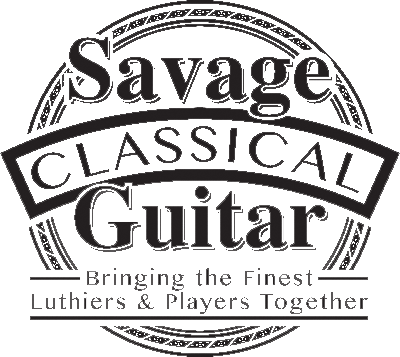by Mark Greenberg
June 2004
Carlos Barbosa-Lima has just gotten back from performing in Washington, D.C., with Venezuelan cuatro-player Gustavo Colina. A big success, his friend and host, Jose Uran tells me. This doesn’t surprise me. Early last year I was part of an equally ecstatic audience that saw a similar show at Weil Recital Hall. And last year’s Barbos-Lima/Colina CD, just re-released as Frenesi on the new Zoho label, is a simply intoxicating affair.
What I like even better is a story he tells in passing. His longtime friend and sponsor, Robert Bialek (who, among other things, helped commission the Ginestera sonata) is now in a senior citizen residence and Barbosa-Lima went to visit, along with Colina and their respective guitar and cuatro. Well, we have to play later anyway, one said to the other. So they did a set right there in the general area that brought all the walkers to a halt. Even the security guards came over to listen, Barbosa-Lima tells me, and that seems to me basic proof of great musicians of great talent — ability to bring traffic to a halt even just in passing.
Such talent put in an initial appearance at age seven. Carlos Barbosa-Lima’s father, who worked for a German pharmaceutical company, decided (as an adult) to learn the guitar and engaged a local teacher in São Paulo, Benedito Moreira, for ten months’ worth of lessons. In the end, he suffered the fate of many an adult novitiate at the classical guitar and gave it up. But young Carlos was listening in and vicariously had begun to learn to play. Barbosa-Lima’s first public appearances as a young prodigy, one imagines, were before the collected druggists and doctors of São Paulo at affairs for his father’s pharmaceutical firm.
Lessons with Moreira continued for two years, along with other lessons of a more adventitious nature: the radio poured out some of the rich cultural life of São Paulo and young Carlos listened attentively and imitated what he heard. These were my first steps to arranging, he now concludes, but at the same time there were lessons in music theory — private lessons, not lessons at school.
His repertoire grew: 50–60 pieces, including some Barrios such as Madrigal Gavotte, some Brazilian pop, some classics, even some works by Isaias Savio, whom he had not yet met. Still, this existence required some further stimulus; what was needed was for fate to intervene.
So fate intervened. Luis Bonfa came to São Paolo for an appearance. A meeting was arranged. Bonfa recognized an extraordinarily talented nine-year-old when he saw one, and told the dad of said nine-year-old as much.
Isais Savio was then (and of course still is) one of the founding fathers of the Brazilian school of classical guitar. Although from Uruguay, he had lived in Brazil since the thirties and had come to love his new country deeply. He was much influenced by Villa-Lobos and his musical nationalism.
I think he was impressed by my playing, Barbosa-Lima now says, but he put my back against the wall. He said: You can make very rapid progress but you will have to work hard. I will treat you like an adult.
Some corrections in right hand position were needed. Remediation consisted in learning Barrios’ “Las Abejas” (The Bees). This will be tough for you, Savio warned, but Barbosa-Lima mastered it almost immediately. A year and a half later, at age 12, Barbosa-Lima gave his first concert. Savio was present, but not on stage. I told my dad and Savio I’d rather be on the stage by myself, Barbosa-Lima adds … Savio’s confidence in his young student now became total; he was excited about what he saw from the audience.
What was on that first program? I asked Barbosa-Lima. A Bach Fugue, a beautiful arrangement by Tarrega of a Chopin Nocturne … with a cadenza for left hand solo that followed a precedent set by Sarasate on violin, a couple of pieces by Castelnuovo-Tedesco, some Barrios pieces and Villa-Lobos … also Lauro (among others), and a piece by Savio himself — “Batucada” — that appears in its latest avatar on Frenisi over forty years later.
The newer stuff was exciting. Lauro … he hadn’t even been published in Brazil yet. I was playing from manuscript (thanks to Savio’s correspondence with some friends of Lauro in Venezuela), Barbosa-Lima recalls. The concert was a success and repeated in Rio two months later. A year later — when Barbosa-Lima was thirteen— came a first record of pieces selected by Savio, essentially similar to the concert program. This was to be the first of many, many other recordings — over forty, perhaps over fifty, Barbosa-Lima tells me. And many more never produced, or perhaps someday to be produced…
Okay, that was São Paulo. But this is now; for after all, are we by the ocean that Barbosa-Lima loves so dearly? No, this is not Brazil but the Bronx, with the nearest sign of nature being Bronx Park across the street. And though Barbosa-Lima lived in New York for a long time, for the last eight years he has lived in San Juan, Puerto Rico. Each year brings an extensive schedule of traveling to concerts around the world. Also, there are always trips to Hawaii. Now he is in New York for some masterclasses at Julliard. Like Savio before him, he was excited about the young talent he saw. All this has taken Barbosa-Lima far beyond São Paulo …
And here he is quick to interrupt. My friend in Rio will get angry if I don’t mention them, too. He refers to the internecine soccer rivalry between the two cities. In many ways I am a Carioca — Rio is in my blood … though my mother was from inland, she met my father and they had their honeymoon in Rio — and Rio is the home of so much of Brazilian music, from Villa-Lobos to the Bossa Nova … Gnattali, Jobim, Baden-Powell, all from Rio.
Barbosa-Lima’s conversation is rich with such names, connections, associations. They are a compact history of the guitar — both classical and otherwise (especially jazz) — from the mid twentieth century onward.
With help and encouragement from Leonardo Ballada, a distinguished Spanish composer, Barbosa-Lima made his U.S. debut in Washington D.C. in 1967. Sponsorship by Sophocles Papas soon ensued. Papas was impressed as Savio and Bonfa had been before and immediately forwarded his new find to his Cyrillic NYC counterpart, Vladimir Bobri.
Thanks to Dr. Carleton Sprague-Smith, a U.S. Cultural Attache, and Guillermo Espinosa, the music director of OaS, a slot was found in the schedule at Carnegie Recital Hall (miraculous even in ’67, Barbosa-Lima points out) to soon permit a highly successful New York debut.
Another name that comes up is that of Italian-born composer Guido Santorsola (1904-94), who lived in Uruguay but visited Brazil often and taught Barbosa-Lima couterpoint. Santorsola wrote extensively for the guitar — solo and chamber pieces and (most important) guitar concertos, and Barbosa-Lima speaks of him with great respect and affection. Here we are talking not of the past, though, but of the future: the guitar concertos are a huge future project, yet to be realized and recorded. Santorsola — I have a feeling that here is a name that we will all know someday.
About the jazz connection there is of course much to say. Barbosa-Lima has already recorded so long and so well for the Concord label that this part of the story is more familiar to me: the wonderful collaborations with Charlie Byrd, John Griggs and Laurindo Almeida. Bobby Scott, the very gifted jazz pianist composer/arranger who wrote “A Taste of Honey” (and “He Ain’t Heavy, He’s My Brother,” Barbosa-Lima reminds me here) is also recalled with emotion. Again we are speaking of the future — of Scott’s compositions for guitar and orchestra — also waiting to be released.
You’d think that piano and guitar wouldn’t work, Barbosa-Lima says, but Bobby Scott influenced my understanding of how it can be done. The guitar has to be rich and the piano economical. Jobim also understood how to play in an understated style like that.
Which brings us back to Brazil, but also New York, where Barbosa-Lima first met Jobim in the early ’80s. He was particularly impressed by my transcription of “Stone Flower,” it showed him how the guitar could give the music a new dimension, Barbosa-Lima recalls. And anyone who has ever heard Barbosa-Lima’s recording, on his splendid album (with Sharon Isbin), Brazil with Love, can understand why.
Jobim would spend springtime in New York and each season would find time to work with Barbosa-Lima on guitar transcriptions to ensure that his subtle harmonies were preserved. Juan Orozco generously donated a Di Giorgio guitar, Barbosa-Lima reminisces, and we kept it over at his house so I wouldn’t have to bring one over on the subway … Jobim thought it was too dangerous.
Speaking of subways, we turn at last to the Guitar Seminar coming up at Mannes this summer. I ask if he ever taught at Mannes. No, but of course he knows Michael Newman and Laura Oltman well. We consider what the schedule might be; as a master, Barbosa-Lima will of course give masterclasses and he speaks highly of the others, players of great talent such as Zanon and Mario Ulloa. I tell him that already ensemble works by Machado have become a summer tradition at the seminar, courtesy of the Garden State’s greatest exponents of Brazilian guitar music — Laura and Michael. Unsurprisingly, as a classical player who has spent so much time cleverly concealed in the Concord Jazz catalogue (Carlos Barbosa-Lima Plays Jobim and Gershwin, a Concord bestseller, has to be mentioned here), Barbosa-Lima speaks highly of Fred Hand, whose work he regards highly.
Now I’m not saying that this will happen, but if we could get Hand and Barbosa-Lima to do a set together…man, it would just about be worth the price of the whole seminar.
Let’s wait and see.









